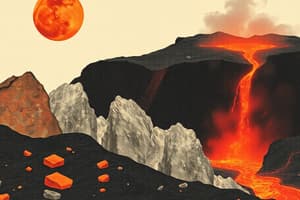Podcast
Questions and Answers
What is the difference between magma and lava?
What is the difference between magma and lava?
Magma is molten rock inside the Earth while lava is magma that reaches the surface.
What do the terms extrusive and intrusive refer to?
What do the terms extrusive and intrusive refer to?
- Extrusive - quick cooling at surface (correct)
- Intrusive - quick cooling at surface
- Extrusive - slow cooling at depth
- Intrusive - quick cooling at surface
What is the difference between volcanic and plutonic igneous rocks?
What is the difference between volcanic and plutonic igneous rocks?
Volcanic rocks are extrusive and formed at the surface, while plutonic rocks are intrusive and formed in the crust.
What determines the difference between volcanic and plutonic rocks?
What determines the difference between volcanic and plutonic rocks?
What is the difference between basalt and gabbro?
What is the difference between basalt and gabbro?
What is the difference between andesite and diorite?
What is the difference between andesite and diorite?
What is the difference between granite and rhyolite?
What is the difference between granite and rhyolite?
What is the difference between obsidian and pumice?
What is the difference between obsidian and pumice?
What is the difference between mafic and felsic rocks?
What is the difference between mafic and felsic rocks?
What rocks are considered mafic, felsic, or intermediate?
What rocks are considered mafic, felsic, or intermediate?
What is the difference between granite and granodiorite?
What is the difference between granite and granodiorite?
Which igneous rock type best represents the Sierra Nevadas?
Which igneous rock type best represents the Sierra Nevadas?
What major compositional layer of the Earth do ultramafic rocks containing olivine or serpentine represent?
What major compositional layer of the Earth do ultramafic rocks containing olivine or serpentine represent?
What are the characteristic rocks of convergent plate boundaries?
What are the characteristic rocks of convergent plate boundaries?
What is a pluton?
What is a pluton?
What is a batholith?
What is a batholith?
Where can you find ancient and young basaltic rocks in California?
Where can you find ancient and young basaltic rocks in California?
Where can you find Mesozoic felsic rocks in California?
Where can you find Mesozoic felsic rocks in California?
Where can you find Quaternary rocks in California?
Where can you find Quaternary rocks in California?
Study Notes
Magma and Lava
- Magma is molten rock located beneath the Earth's surface; when it reaches the surface, it becomes lava.
- Extrusive igneous rocks form from rapidly cooled lava, while intrusive igneous rocks crystallize from slowly cooled magma deep underground.
Volcanic vs. Plutonic Igneous Rocks
- Volcanic rocks (extrusive) solidify at the Earth’s surface; examples include basalt and rhyolite.
- Plutonic rocks (intrusive) solidify beneath the surface; examples include gabbro and granite.
- Texture differences: intrusive rocks tend to be coarse-grained, while extrusive are usually fine-grained or glassy.
Types of Igneous Rocks
- Basalt is a volcanic mafic rock; gabbro is its plutonic counterpart.
- Andesite (volcanic) and diorite (plutonic) are intermediate rocks found at convergent boundaries.
- Granite (plutonic) is felsic, while rhyolite (volcanic) is its extrusive equivalent.
Obsidian vs. Pumice
- Both obsidian and pumice are volcanic rocks; obsidian is dense and glassy, while pumice is formed from gas-rich lava, giving it a frothy texture.
Mafic and Felsic Rocks
- Mafic rocks are rich in iron and magnesium, darker, denser, and typically contain little to no water; examples include basalt and gabbro.
- Felsic rocks are high in silica, lighter, less dense, and contain water in their mineral compositions; examples include quartz-rich rocks like granite.
Granite vs. Granodiorite
- Granite contains less magnesium and iron, leading to a higher quartz content.
- Granodiorite contains more calcium and sodium, resulting in the presence of more dark minerals.
Regional Igneous Rock Abundance
- Sierra Nevadas are primarily composed of granitic rocks from the Mesozoic era.
- The Cascades volcanic chain mostly features andesitic rock.
Ultramafic Rocks
- Ultramafic rocks, such as those containing olivine or serpentine, are indicative of the oceanic crust.
Igneous Rock at Plate Boundaries
- Convergent boundaries typically show granites, rhyolites, andesites, and diorites.
- Divergent boundaries generally have basalt and gabbro.
- Transform faults feature a variety of igneous rock types.
Plutons and Batholiths
- A pluton is a body of intrusive igneous rock; a batholith is a large plutonic intrusion.
- The Sierra Nevada contains a prominent batholith made up of granitic rocks.
Basaltic Rocks in California
- Mesozoic basaltic rocks are found in regions like Mount Shasta, Lassen, and the Cascade volcanoes.
- Young basaltic rocks from the Late Cenozoic are located in the Mojave and the eastern Basin Range.
Felsic Rocks in California
- Mesozoic felsic rocks are primarily found in the Sierra Nevadas.
- Quaternary rocks are located in the Coast Ranges, Mojave, eastern California Basin Ranges, and the northern Cascade andesitic volcanoes.
Studying That Suits You
Use AI to generate personalized quizzes and flashcards to suit your learning preferences.
Description
Explore the fascinating world of igneous rocks, including the differences between volcanic and plutonic types. This quiz covers magma and lava, types of igneous rocks, and their textures. Test your knowledge on basalt, granite, obsidian, and more!




